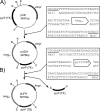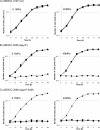Genetic manipulations of the hyperthermophilic piezophilic archaeon Thermococcus barophilus
- PMID: 24487541
- PMCID: PMC3993132
- DOI: 10.1128/AEM.00084-14
Genetic manipulations of the hyperthermophilic piezophilic archaeon Thermococcus barophilus
Abstract
In this study, we developed a gene disruption system for Thermococcus barophilus using simvastatin for positive selection and 5-fluoroorotic acid (5-FOA) for negative selection or counterselection to obtain markerless deletion mutants using single- and double-crossover events. Disruption plasmids carrying flanking regions of each targeted gene were constructed and introduced by transformation into wild-type T. barophilus MP cells. Initially, a pyrF deletion mutant was obtained as a starting point for the construction of further markerless mutants. A deletion of the hisB gene was also constructed in the UBOCC-3256 (ΔpyrF) background, generating a strain (UBOCC-3260) that was auxotrophic for histidine. A functional pyrF or hisB allele from T. barophilus was inserted into the chromosome of UBOCC-3256 (ΔpyrF) or UBOCC-3260 (ΔpyrF ΔhisB), allowing homologous complementation of these mutants. The piezophilic genetic tools developed in this study provide a way to construct strains with multiple genetic backgrounds that will allow further genetic studies for hyperthermophilic piezophilic archaea.
Figures




References
-
- Marteinsson VT, Birrien JL, Reysenbach AL, Vernet M, Marie D, Gambacorta A, Messner P, Sleytr UB, Prieur D. 1999. Thermococcus barophilus sp. nov., a new barophilic and hyperthermophilic archaeon isolated under high hydrostatic pressure from a deep-sea hydrothermal vent. Int. J. Syst. Bacteriol. 49:351–359. 10.1099/00207713-49-2-351 - DOI - PubMed
-
- Alain K, Marteinsson VT, Miroshnichenko ML, Bonch-Osmolovskaya EA, Prieur D, Birrien JL. 2002. Marinitoga piezophila sp. nov., a rod-shaped, thermo-piezophilic bacterium isolated under high hydrostatic pressure from a deep-sea hydrothermal vent. Int. J. Syst. Evol. Microbiol. 52:1331–1339. 10.1099/ijs.0.02068-0 - DOI - PubMed
-
- Takai K, Nakamura K, Toki T, Tsunogai U, Miyazaki M, Miyazaki J, Hirayama H, Nakagawa S, Nunoura T, Horikoshi K. 2008. Cell proliferation at 122 degrees C and isotopically heavy CH4 production by a hyperthermophilic methanogen under high-pressure cultivation. Proc. Natl. Acad. Sci. U. S. A. 105:10949–10954. 10.1073/pnas.0712334105 - DOI - PMC - PubMed
Publication types
MeSH terms
LinkOut - more resources
Full Text Sources
Other Literature Sources

